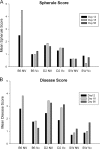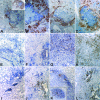Vaccine-induced cellular immune responses differ from innate responses in susceptible and resistant strains of mice infected with Coccidioides posadasii
- PMID: 18852250
- PMCID: PMC2583549
- DOI: 10.1128/IAI.00885-08
Vaccine-induced cellular immune responses differ from innate responses in susceptible and resistant strains of mice infected with Coccidioides posadasii
Abstract
Susceptibility to Coccidioides spp. varies widely in humans and other mammals and also among individuals within a species. Among strains of mice with various susceptibilities, immunohistopathology revealed that C57BL/6 mice were highly susceptible to the disease following intranasal infection, DBA/2n mice were intermediate, and Swiss-Webster mice were innately resistant. Resistant Swiss-Webster mice developed prominent perivascular/peribronchiolar lymphocytic cuffing and well-formed granulomas with few fungal elements and debris in the necrotic center, surrounded by a mantle of macrophages, lymphocytes, and fibrocytes. Susceptible C57BL/6 mice became moribund between 14 and 18 days postinfection, with overwhelming numbers of neutrophils and spherules and very few T cells, the drastic reduction of which was associated with failure and death, while intermediate DBA/2n mice controlled the fungal burden but demonstrated progressive lung inflammation with prominent suppuration, and they deteriorated clinically. Vaccinated C57BL/6 mice had an early and robust lymphocyte response, which included significantly higher Mac2(+), CD3(+), and CD4(+) cell scores on day 18 than those of innately resistant SW mice and DBA/2n mice; they also had prominent perivascular/peribronchiolar lymphocytic infiltrates not present in their unvaccinated counterparts, and they appeared to be resolving lesions by day 56 compared to the other two strains, based on significantly lower disease scores and observably smaller and fewer lesions with few spherules and neutrophils.
Figures







References
-
- Abuodeh, R. O., L. F. Shubitz, E. Siegel, S. Snyder, T. Peng, K. I. Orsborn, E. Brummer, D. A. Stevens, and J. N. Galgiani. 1999. Resistance to Coccidioides immitis in mice after immunization with recombinant protein or a DNA vaccine of a proline-rich antigen. Infect. Immun. 672935-2940. - PMC - PubMed
-
- Baldridge, J. B., and R. T. Crane. 1999. Monophosphoryl lipid A (MPL) formulations for the next generation of vaccines. Methods 19103-107. - PubMed
Publication types
MeSH terms
Substances
Grants and funding
LinkOut - more resources
Full Text Sources
Other Literature Sources
Medical
Molecular Biology Databases
Research Materials
Miscellaneous

